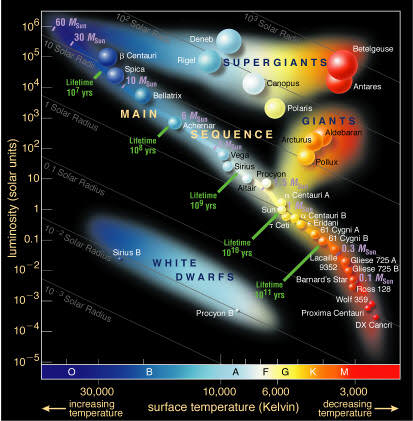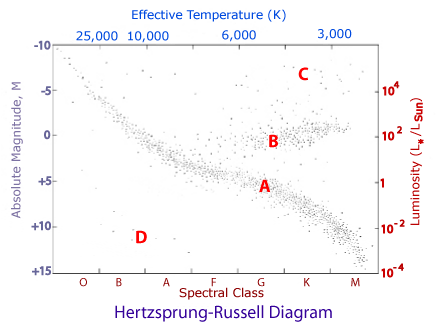The Horizontal Axis of the Hr Diagram Is
The X-axis is. Hot but dim Supergiant.

Hertzsprung Russell Diagram Universe Today
Each star is represented by a dot.

. Which of the following properties of stars is directly observed ie it can be measured by a calibrated instrument on a telescope from a single observation without a need for additional calculations. The Hertzsprung-Russell diagram can also be used to measure the distance of star clusters from the Earth. They follow the pattern The hotter the brighter the cooler the dimmer White Dwarf.
A third alternative along the horizontal axis is to use spectral class. Stars that fit in the diagonal on the HR diagram. These diagrams called the Hertzsprung-Russell or HR diagrams plot luminosity in solar units on the Y axis and stellar temperature on the X axis as shown below.
The HertzsprungRussell diagram abbreviated as HR diagram HR diagram or HRD is a scatter plot of stars showing the relationship between the stars absolute magnitudes or luminosities versus their stellar classifications or effective temperaturesThe diagram was created independently in 1911 by Ejnar Hertzsprung and by Henry Norris Russell in 1913 and. So often the temperature scale on the horizontal axis is replaced by spectral types OBAFGKM. Question 29 1 point A stars position along the horizontal axis of an H-R diagram tells us all of the following except the stars luminosity surface temperature surface color spectral type.
Chandra X-Ray Observatory If you want to plot something the first thing required is the axes of the plot. You may see any of these three variables on the horizontal axis. How much energy a star radiates in 1 sec.
Pages 143 This preview shows page 65 -. One quirk here is that the temperature is plotted in reverse order with high temperature around 30000 - 40000 K on the left and the cooler temperature around 2500 K on the right. What exactly does the diagram show.
Based on the position of a star on the H-R diagram we can find out its luminosity color and spectral class. Vertical axis shows luminosityabsolute magnitude. The Hertzsprung-Russell diagram is one of the most important tools in the study of stellar evolutionDeveloped independently in the early 1900s by Ejnar Hertzsprung and Henry Norris Russell it plots the temperature of stars against their luminosity the theoretical HR diagram or the colour of stars or spectral type against their absolute magnitude the observational HR.
What this means is that instead of each tick mark on the y-axis increasing by 1 unit 12345 the y-axis tick marks increase by a factor of 10 0001 001 01 1 10 100 1000. Luminosity is the total energy output of the star. Note that the x axis horizontal axis of the hr.
Usually this is labeled using the Kelvin temperature scale. It is also often called the H-R diagram or colour-magnitude diagram. See the answer See the answer done loading.
But thats not the only quantity which one can find on this axis. Stars at the very top of the HR diagram that are WAY too bright for their temperature. Note that the x axis horizontal axis of the HR Diagram can be given in many.
Recall from The Stars. How brightdim a star appears compared to Sun Horizontal axis shows surface temperature in K NOTICE. Goes from high temps at left side to lower temps at right side.
The Hertzsprung-Russell diagram Source. Question 30 1 point Saved Which of the following is not a method astronomers use to determine the physical. Stars at the bottom of the HR diagram that are way too dim for their temperature.
One of the best ways to summarize all of these details about how a star or protostar changes with time is to use a Hertzsprung-Russell HR diagram. There are several equivalent versions of the Hertzspung-Russell diagrams of stars. As a star goes through the stages of its life its luminosity and temperature.
In the Hertzsprung-Russell diagram the y-axis represents the luminosity that increases with the increasing y. In order to represent this wide range of values in one diagram the Y-axis of a CMD or HR diagram is usually plotted on a logarithmic scale. The horizontal axis The horizontal axis is in the original labelled spectral class.
The chart was created by Ejnar Hertzsprung and Henry Norris Russell in about 1910. There are two other quantities which are roughly equivalent and which frequently appear in its place. We plot stars surface temperatures in degrees Kelvin on the x-axis horizontal axis.
The second-most concentration of stars is along a horizontal branch. The effective temperature of a star is plotted on the horizontal axis of an H-R diagram. A stars position along the horizontal axis of an H-R diagram tells us all of the following except the stars radius.
Our Sun lies somewhere at the middle of the graph. Advanced Physics questions and answers. The diagram below shows the possible axes for an H-R diagram.
It is a very useful graph because it can be used to chart the life cycle of a star. Lets try plotting color on the horizontal axis and apparent V magnitude on the vertical axis. The horizontal axis is either the surface temperature increasing to the left.
A Celestial Census that when looking at an HR diagram the temperature the horizontal axis is plotted increasing toward the left. This had the advantage of being more linear than temperature nicely spaces letters. Course Title EDUC 1313.
Of course all three quantities are essentially showing the same thing. That looks almost like random scatter although it does show that there are lots of stars with B-V colors. The vertical axis measures the luminosity increasing upwards or absolute magnitude increasing downwards.
The horizontal axis represents the stars surface temperature not the stars core temperature we cannot see into the core of a star only its surface. In most graphs and diagrams zero or the smaller numbers exist to the left on the diagram. The horizontal axis of the HR diagram is.
If colour index B-V rather than effective temperature is used then it goes from negative blue on the left to positive red on the right. That is called the Hertzsprung-Russell or HR diagram and each star occupies a point. This problem has been solved.
The Hertzsprung-Russell HR diagram If you look carefully at stars in the sky youll see that they arent all the same color. School Bataan Peninsula State University in Balanga. The horizontal axis is temperature and the vertical axis is the absolute magnitude.

Classifying Stars The Hertzsprung Russell Diagram
No comments for "The Horizontal Axis of the Hr Diagram Is"
Post a Comment